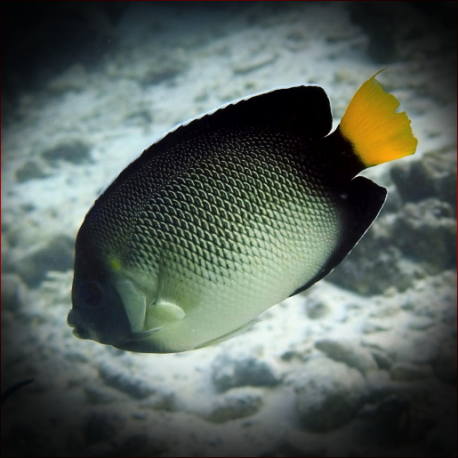More info
Datasheet
| Minimum Tank Size | 600 litres / 158.50 US gallons |
| Maximum Size | 15.0cm / 5.91inches |
| Reef Compatible | Not reef safe |
| Temperament | Might be aggressive towards similar species |
| Temperature | 22.2°C / 71.96°F - 25.6°C / 78.08°F |
| Specific Gravity | 1.020-1.025 |
| Carbonate Hardness | 8-12 |
| pH | 8.1-8.4 |
General Description
The Yellowtail Angelfish (Apolemichthys xanthurus) belongs to the Pomacanthidae family and is known for its striking appearance with a yellow tail fin. These medium-sized Angelfish vary in hardiness and aquarium suitability within the Apolemichthys genus, with preferences for specific food needs. They are generally less aggressive compared to other Angelfish species.
Aquarium Suitability
Suitable for aquariums with caution, Yellowtail Angelfish may display aggression towards similar species. They are not reef-safe due to their tendency to nip at and consume soft corals and LPS, but can be housed in coral aquariums with careful selection of compatible corals.
Demands, Care, and Hardiness
These Angelfish have medium hardiness and require places to hide, particularly when introduced into a new aquarium. They thrive in aquariums with high-quality water conditions, a varied diet including larger crustaceans, macroalgae, and small crustaceans, and sufficient space with hiding spots to prevent aggression.
Reef Suitability
Yellowtail Angelfish are not suitable for reef tanks due to their inclination to consume soft corals and LPS. They are better suited for fish-only setups or carefully curated coral aquariums where compatible corals like Hammer corals, Bubble corals, and Star polyps can coexist.
Aquarium Setup
To house Yellowtail Angelfish, a tank of at least 600 liters is recommended. Providing hiding spots is crucial, especially during the initial introduction phase. Selecting corals resistant to nibbling, such as Disc anemones, can help prevent damage. Varied sizes and species of Angelfish in the aquarium can enhance compatibility.
Behaviour
Yellowtail Angelfish might exhibit aggression towards similar species, emphasizing the importance of choosing different-sized and less aggressive fish for a harmonious tank environment. They may require acclimatization due to potential stress resulting from relocation and the presence of new tank mates.
Feeding and Diet
In captivity, Yellowtail Angelfish should be fed a diverse diet consisting of larger crustaceans, macroalgae, and small crustaceans to ensure optimal health and nutrition. Providing a varied diet helps them adapt to stressors like the introduction of new tank inhabitants.
Dimorphism
If captive reproduction is achieved, the dimorphism of Yellowtail Angelfish may become more apparent. Understanding the reproductive behavior and successful breeding of these species can contribute to their sustainability in captivity.
Habitat and Distribution
Yellowtail Angelfish are found in the Western Indian Ocean, specifically from Mauritius to India and Sri Lanka. They inhabit areas with suitable coral reefs and rocky outcrops, displaying distinct behaviors and interactions within their natural environment.

